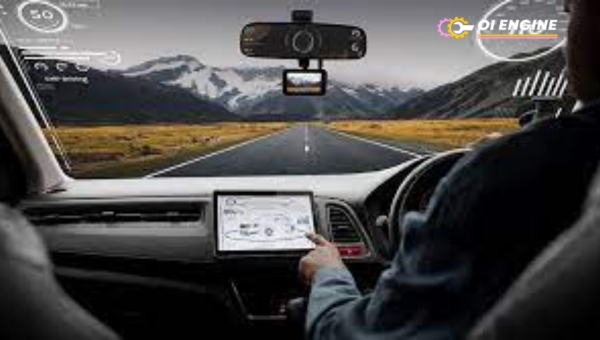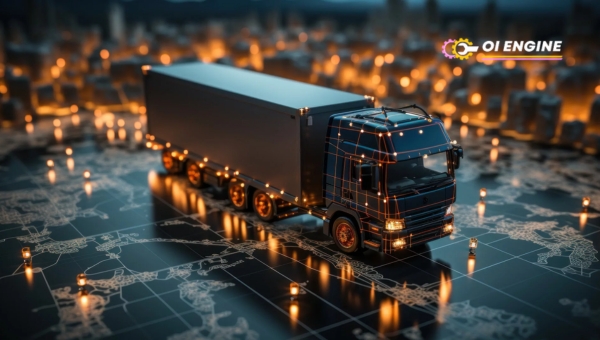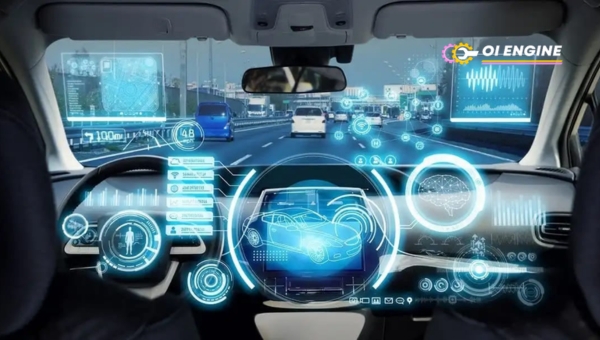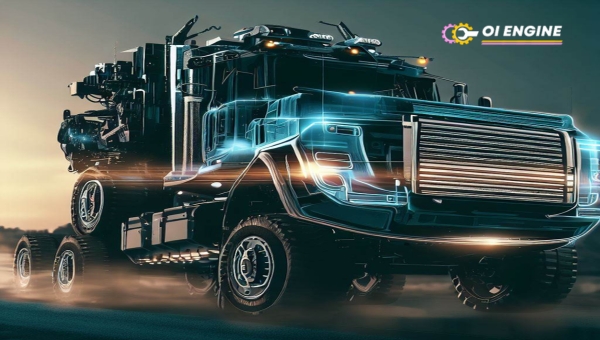Have you ever imagined a world where massive trucks drive themselves, delivering goods without a human at the wheel? That’s not science fiction anymore; it’s what we call autonomous trucking.
These trucks are more than just vehicles—they represent a potential transformation of how goods travel across our highways.
With advancements in technology, the day isn’t far when these robot-like trucks could become an everyday reality. But what does this mean for us and the countless truck drivers who crisscross the country?
Autonomous trucking is stepping out of its humble beginnings and into the fast lane. Think of it as driverless big rigs hauling cargo while their human counterparts relax or manage logistics from afar.
This leap towards automation promises efficiency, safety, and maybe even greener roads. However, there are real concerns that need addressing too—mainly related to jobs in transportation and ensuring this tech is truly road-ready.
Autonomous Trucking – An Insight into Autonomous Driving Levels
Autonomous trucking is like having a robot do the driving instead of a person. It’s a big change that’s happening right now, and it has different stages called levels of autonomy.
These levels describe how much the truck can drive on its own without needing a human driver to take over.
What is autonomous driving and the various levels of autonomy?
Autonomous driving is when cars and trucks can drive themselves using cameras, sensors, and computers. This technology makes decisions about speed, direction, and safety without a person’s help. The idea of autonomy comes in five main steps or levels:
- Level 0 (No Automation): At this stage, there’s no self-driving happening at all. It’s all up to the human driver.
- Level 1 (Driver Assistance): The vehicle can do one thing by itself, like steering or controlling speed when you are on a highway.
- Level 2 (Partial Automation): Here the vehicle can steer and control speed at the same time but still needs you to pay attention and be ready to take over if needed.
- Level 3 (Conditional Automation): At this level, the vehicle can manage most aspects of driving in certain conditions but asks for your help when things get tough.
- Level 4 (High Automation): The vehicle is nearly fully self-sufficient in some places like highways or special areas but might still need you for more complex environments like city streets.
- Level 5 (Full Automation): This is where we dream about being – cars or trucks doing everything on their own everywhere with zero need for you.
How does autonomous trucking fit into these levels?
Here is where we see the fit of autonomous trucking within these levels:
- Level 0 and Level 1: There isn’t much room for autonomous trucking at these levels since human drivers are still doing most of everything.
- Level 2: Autonomous trucking starts to sneak in a bit here. For example, technologies giving trucks the ability to follow one another closely known as platooning. This can make highway driving more efficient and safe.
- Level 3: Autonomous features could do a lot on highways like keeping lanes or cruising at steady speed without intervention. However, drivers are still necessary for interpreting more complex situations such as construction work ahead or handling sudden weather changes.
- Level 4 and Level 5: These are the ultimate goals for the autonomous trucking sector. Trucks would be capable enough to manage all sorts of scenarios without any human interaction. They’d find their way, take care of safety, and respect traffic rules – all by themselves.
It’s important to bear in mind that jumping from each level to the next one isn’t simple and smooth always because it means overcoming huge technological challenges.
But gradual progress matters that brings us closer to fully autonomous trucking revolutionizing logistics management on a large scale!
Also Read: Top 12 Semi-Truck Financing Companies 2024
The Turbulent Journey of Autonomous Vehicles

Embarking on a retrospective journey of autonomous vehicles, one tends to witness the fascinating transformation they’ve undergone.
Setting sail from primitive self-steering cars to advanced artificial intelligence counterparts, this timeline has surely seen its standout milestones as well as hindrances.
Self-steering to False Claims: A Historical Perspective on Robot Cars
In the early phase, self-steering was a notable liberty that cars possessed. This was a rather basic feature back in the day and worked using mechanical wonders more so than digital components.
Fast forward to today’s time and age where I hear claims about cars completely driven by robots – sounds intriguing yet overwhelming, doesn’t it? These developments have been nothing less than extraordinary, giving birth to an entirely new era popularly known as Autonomous Trucking.
However such advancements didn’t come without hitches. Understanding this autonomous wonder requires decoding its intricacies which isn’t everyone’s cup of tea – leading hence to false claims.
The aura surrounding these next-gen vehicles often tends to manifest incorrect understandings and information among individuals who aren’t particularly car geeks.
Why is Current Sentiment Towards Vehicle Autonomy Mixed?
The current tilt towards vehicle autonomy spells out mixed sentiment for several reasons. It all boils down to one’s perspective on change and evolution with technology.
For some, advancements like autonomous trucking seem like stepping into the future– offering efficiency, lower cost, and even fewer accidents considering these are robot-driven machines we’re talking about.
In contrast though, those critical of technology reign fear loss of jobs given how AI can replace several roles within the industry–most familiar being truck drivers in this case.
The technological learning curve also intimidates many potential adopters who are unsure if they can cope up with understanding or trusting such significant change moving away from traditional knowledge we have about cars.
Despite promises of convenience & efficiency through vehicle autonomy, concerns around job preservation & slow adaptability provide a contrasting viewpoint resulting in a mixed sentiment overall.
The Role of Freight Industry in the Rise of Autonomous Trucking
The freight transportation sector plays a significant part in the perpetual evolution and rise of autonomous trucking. Here are five key elements that outline its role:
- Market Demand: As an ever-growing sector, the freight industry’s need for efficient and effective transportation methods is increasingly high. In response to this demand, autonomous trucking has seen a rapid increase.
- Transportation Efficiency: Autonomous trucks have been designed to run continuously without requiring rest breaks, optimizing shipment times and considerably boosting transport efficiency across extensive distances.
- Safety Concerns: The freight industry is constantly seeking safer transit methods for its commodities. Autonomous trucks, equipped with advanced safety features like low brake reaction time and AI-supported collision detection systems hold promise for safer transit operations.
- Cost Reduction: Labor costs account for a substantial portion of operating expenses in the freight industry. With autonomous trucks replacing human drivers, companies can significantly curb their overhead expenditures.
- Environmental Care: In today’s eco-aware society, cutting down on harmful emissions is not just socially responsible but can also lead to cost savings through improved fuel efficiency — a potential upside offered by autonomous trucking technology.
Insights into Today’s Wages and Working Conditions in Trucking
Understanding the present state of wages and working conditions is vital to appreciate why autonomous trucking is making such waves. Let’s delve into some vital points:
- Long Hours: One common attribute among truck drivers across this industry involves long, often irregular hours on the road. It’s not unusual for them to work 14-hour shifts, which can take a toll on their well-being.
- Fluctuating Pay: While some truckers earn decent salaries, wage fluctuation is a significant issue depending largely on things like the size or reputation of employers, distances covered, trucks’ load weight, etc.
- Health Issues: Staying seated for extended periods isn’t exactly healthy. This sedentary lifestyle can lead to numerous health issues ranging from back pains to cardiovascular diseases.
- Emotional Strain: Long stints away from family give rise to emotional strain impacting drivers’ mental health substantially.
These increasingly challenging aspects are prompting many within this industry to look towards technological advancements like autonomous trucking as potential solutions.
Present Working Conditions in the Trucking Industry
Looking past wages alone, let us explore broader issues surrounding today’s working conditions:
- Road Safety Risks: Almost by definition, being a long-haul driver implies spending vast amounts of time on potentially dangerous roads which may increase the chances of accident risk.
- Job Security Issues: The precarious nature of jobs within this sector due much in part due large-scale movements towards digitization poses concerns about future job security.
- Lack Of Breaks And Rest: Little time for rest during rigorous schedules often results in exhaustion, detrimentally affecting drivers’ health and work quality.
- Isolation: The isolated nature of truck driving over extensive distances can induce feelings of loneliness, subsequently impacting their overall well-being.
At a glance, working environments within this industry are far from ideal. By introducing autonomous trucks to the equation, many believe it could inspire significant shifts towards improved working conditions.
Also Read: Unlock Postal Productivity With Postage Meters
Automation, Policy Intervention, and Job Creation in Trucking

As we propel ourselves steadily into the future, we cannot ignore the rising tide of automation washing over various industries.
This wave has certainly not spared trucking. While there are high expectations of heightened efficiency and lowered costs from autonomous trucking, it poses a significant impact on employment and wage structures.
Thus, like two sides of the same coin, these technological innovations bring about their own set of challenges and opportunities.
How Automation Might Change the Wage Structure in Trucking?
The advent of autonomous trucking might significantly change the current wage structure in this industry. Let’s delve deeper:
- Reduction in labor costs: Autonomous trucks imply fewer human drivers on payrolls which could lead to substantial reductions in labor costs.
- Shift towards technical roles: As manual driving jobs decrease, an increase is predicted for skilled technical positions such as fleet management or maintenance roles.
- Repercussions for non-driving roles: Non-driving roles tied to traditional truck operations may experience scale-down or modifications owing to changes introduced by automation
In essence, automation has the potential to create a wide disparity among wages within the industry but could also lead to better compensation for certain high-skilled jobs.
The Importance of Policy Interventions In Ensuring Job Quality
Just as a gardener prunes a beautiful flower plant with care and precision to help it grow better; policy interventions are necessary when managing sectors influenced by rapid technological advancements like automated trucking. Here are five reasons why policy interventions ensure job quality:
- Design guidelines: Policies help design rules concerning safety standards thus offering employees security against unforeseen complications.
- Promotion of skill development: Stringent policies can encourage organizations towards staff training programs which would contribute substantially to reducing skill gaps during transition periods.
- Protection against unfair dismissal: Legislation can safeguard workers’ rights avoiding arbitrary layoffs as we transition towards more autonomous systems.
- Establishing minimum wage: Conditional policy-making can ensure competitive but fair remuneration for replacement roles created by automation.
- Managing transition: Government regulations can lessen the adverse social impact that might come with swift automation, by encouraging gradual and inclusive changes.
Thoughtful and strategic policy interventions are vital to guide this rapid technological transition in a way that benefits both organizations and their employees alike.
A Call for Proactive Industry and Public Policy Actions
In the autonomous trucking landscape, one critical approach stands out. That is the need for proactive actions both from industry stakeholders and public policymakers.
Such forward-looking moves are necessary to ensure that the transition towards autonomous trucking leads to broad benefits rather than harm.
Why proactive actions are needed for automation to deliver broad benefits?
In my view, proactive steps are needed to ensure that this technology fulfills its potential rather than causing disruption. Here’s why:
- Job Impact Management: If we move headlong into automation without a plan, it’s likely many people could lose their jobs. But with proper retraining and reskilling programs in place, we can help workers transition into new roles.
- Public Safety Measures: Autonomous trucks may pose new risks on our roads if they’re not properly managed. Therefore, robust safety regulations need to be developed and implemented well before these vehicles populate our highways in significant numbers.
- Setting Fair Standards: We also need strong industry guidelines around fair pay and working conditions, so that those remaining in the trucking profession aren’t exploited as companies scramble to cut costs.
- Managing Environmental Impacts: Although one of the promises of autonomous trucks is improved fuel efficiency (and therefore less environmental impact), it’s important that we don’t take this for granted but instead actively monitor and manage these outcomes.
- Stakeholder Engagement: Finally, it’s essential that all relevant stakeholders – from truck drivers to policymakers – have an active role in shaping this future technology so that everyone’s interests are considered fairly.
Exploring potential economic, environmental, and social benefits from autonomous trucking
It’s undeniable that with proactive industry and policy measures, autonomous trucking brings a myriad of potential benefits;
Economic Benefits:
- Cost Savings: Autonomous trucks can operate continuously without breaks, reducing the time and money spent on rest periods.
- Efficiency Improvements: Advanced technologies in these trucks can optimize fuel consumption and maintenance costs.
- Enhanced Productivity: With machines doing the work, productivity is expected to skyrocket, enhancing economic growth.
Environmental Benefits:
- Reduced Carbon Footprint: Autonomous trucking promises significant reductions in greenhouse gas emissions due to less idling time and optimized travel routes.
- Improved Energy Efficiency: Through advanced algorithms and precise control over its operations, autonomous trucks are expected to have higher energy efficiency than traditional trucks.
Social Benefits:
- Reduced Road Accidents: By eliminating human error – one of the leading causes of accidents – self-driving trucks could significantly lower road accident rates.
- Job Creation: While it may affect existing trucking jobs, the rise of autonomous vehicles would also create new jobs in sectors like technology development, data analysis, and fleet maintenance.
These are but a few mentioned benefits. With proactive strategies from industry leaders and lawmakers alike, we’ll be better placed to capitalize on these opportunities while minimizing any potential harm that could come from this transition.
In other words, realizing the promise of autonomous trucking requires not just innovative technology but smart policies and practices as well.
Also Read: Top 12 Semi-Truck Financing Companies 2024
Navigating Through Uncertainties – Future Impacts of Autonomous Trucking

As we stand at the threshold of a new era in the trucking industry, the concept of autonomous trucking presents its own set of uncertainties.
These unknown factors might impact not just this particular sector but also have potential spin-off effects on social, environmental, and economic landscapes across the world.
Wading through these uncertainties might prove challenging, yet it is an essential step to better understand and prepare for future impacts.
What are the uncertainties autonomous trucking brings?
Undoubtedly as advanced as it is exciting, autonomous trucking carries with it a batch of unanswered questions.
Pinpointed below are five significant areas where the foggy path into this new age needs lighting.
- Job Security: The advent of self-driving trucks raises logical concerns about job displacement among drivers. Specifically, industry workers wonder what’s left for them once trucks begin to drive themselves.
- Safety Measures: Equally pertinent is the question about safety provisions. What happens should an autonomous vehicle fail mid-transit? Itlobaf signs a strike risk present with assessing safety performance based merely on disengagement rates provided by companies.
- Policy Regulation – As much promise as driverless technology holds for reduced carbon footprints and faster transport times – there’s an evident absence of adequate regulatory policies effectively governing or monitoring it.
- Data Privacy – Today’s world teeters precariously between smart solutions and privacy breaches; hence data privacy becomes a vital concern when we’re talking about vehicles that run essentially on data.
- Infrastructure Compatibility – Will our current roadways be suitable to accommodate these smart machines? If modifications are required, who will bear responsibility – public agencies or private firms?
My view posits that while each worry isn’t groundless, they aren’t insurmountable either — continuous development in technology, combining in-hand with active policy-making could help mitigate these concerns.
The key lies in being open to and prepared for change; for it is only in evolution that we uncover the path to progress.
FAQs
What is an autonomous delivery truck?
An autonomous delivery truck is essentially a vehicle that can operate without human input. It utilizes advanced technology such as AI, sensors, and GPS to drive itself and deliver goods.
Is autonomous trucking the future?
Yes, many believe that autonomous trucking does represent the future of freight transportation. It has the potential to lower costs, improve efficiency, and address the industry’s driver shortage issue.
Are there any fully autonomous trucks?
While there are vehicles capable of some level of self-driving under specific conditions on public roads today, we have yet to see a fully operational self-driving truck being able to handle all driving tasks without human intervention.
How big is the autonomous trucking industry?
While it’s still in its early stages with prototypes and pilot projects ongoing globally, experts predict this market can balloon into a multibillion-dollar industry as technology matures and policy allows for wider implementation.
Are autonomous trucks legal?
The legality of these vehicles varies from region to region. Some states in the U.S., for instance, have begun allowing testing of semi-autonomous trucks on their highways. However, comprehensive federal regulation is still needed.
Also Read: Top 26 Load Boards In 2024
Conclusion
The advent of autonomous trucking is undeniably bringing sweeping changes to our economy, society, and environment.
While it does offer promising benefits in terms of efficiency and sustainability, we must also navigate through uncertainties such as job losses and the need for new regulations.
As individuals and a collective, it’s of utmost importance that we stay aware and proactive in addressing these unexpected challenges.
Through careful policy interventions and attentive industry actions, we ensure that the advent of autonomous trucking becomes a harbinger of holistic progress rather than disruptive chaos.
